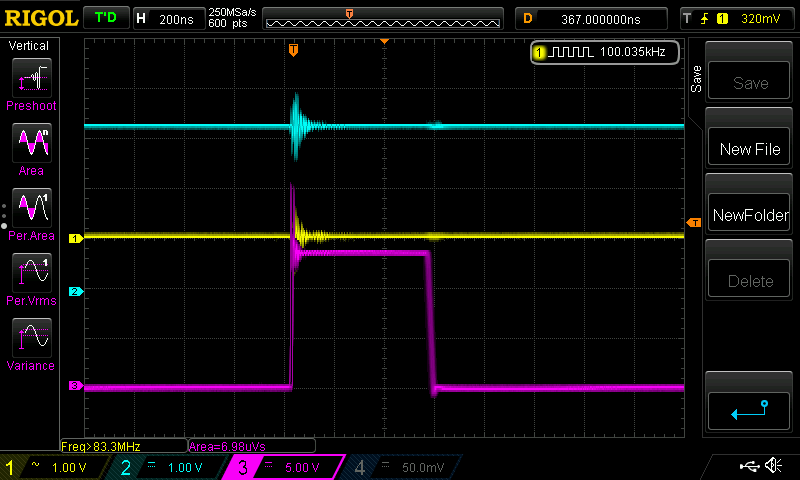I have a design that integrates a TPS5410 based DC/DC converter to provide 3.3V to an ESP8266.
After building up a small bach of prototypes, I have some where the ESP keeps rebooting periodically which is generally associated with an issue on the power supply.
I have a 100nF ceramic capacitor right between 3V3 and GND at the ESPs VCC pin and a 470uF electrolytic capacitor to ground directly at the 3V3 output at the DC/DC stage (right behind the inductance)
Looking at the scope, I see around 50-150mV high frequency content on the 3V3 line at the ESP, but there is no significant difference between the good and the bad parts. I have tried triggering off the serial output to see when the reset happens (usually, the part needs about 30ms between the reset and the first boot loader messages) but was unable to find anything unusual on the 3V3 line happening up to 1.5s before the reboot.
I then turned to the DC/DC stage itself and found a marked difference in the PH signal:
this is a good part, apart form some ringing, the rising edge looks like it does in the datasheet
This is one of the bad parts, notice the shoulder before the rising edge of the PH signal. This shoulder is present with all the troublesome parts I have looked at and absent with all the good parts.
this is the dc/dc stage, please note that the output capacities are drawn on the digital part of the design sheet, but are in fact across 3V3 and GND with the values given above.
here's the board layout. My ground reference for the traces above is the gnd pin on the ESP (the bottom layer is 2/3rd GND flood filled, so the highest GND impedance would pe the short trace from the pin to the VIA and the VIA itself - neglectible in my view.
C1 is directly across 3V3/GND at L1
C2 is on the bottom layer across 3V3/GND a few minimeters from the 3V3 pin
C3 and Cin are very close to the TPS5410
I assume there is something wrong in the direct vincinity of the TPS5410, creating that strange shoulder - I have measured C4, D1 and L1 for correct solder points as I have all the pins of U1(the TPS5410)
It should be noted that at the time of taking those traces, there was no current through the MOSFETs on the bottom side nor were they being switched.
I would appreciate any help in figuring out what creates this switching behaviour and if it could be the source of the issue I'm seeing - it certainly correlates with it.
the eagle files are here: github.com/.../v2.2
kind regards
pj




